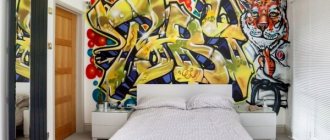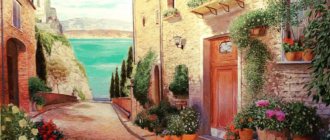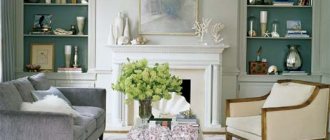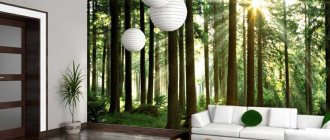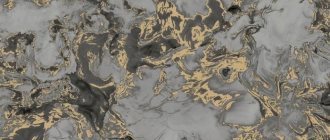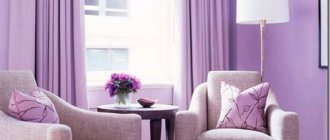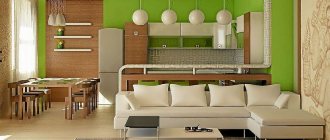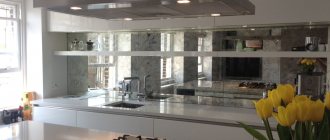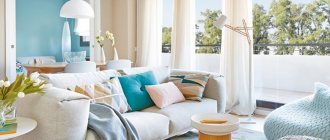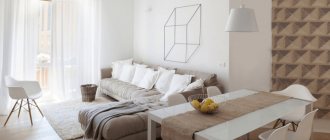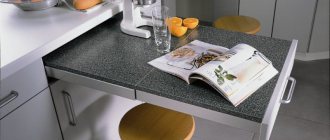Over the course of many centuries, our ancestors mastered and improved the technique of applying patterns to surfaces. The accumulated experience as a result of a complex path of development, from primitive sketches on rocks to brilliant masterpieces of great artists, has allowed a person to apply art techniques in their homes, offices, and commercial premises. Wall painting gives you the opportunity to express your creativity. The decorative interior not only pleases with its beauty, but is also a source of pride for the author.
Interesting techniques for painting walls in 2022
Painting can be created in various techniques, among which the most popular and effective are noted:
- Fresco and alsecco;
- Three-dimensional painting (similar to a bas-relief) and graffiti;
- Airbrush;
- Fluorescent acrylic paintings;
- Grisaille. This will require high skill, as it is done with colors of different saturations. The technique is similar to graphics.
Separately, it is worth noting the method of using stencils. This option is ideal for beginners who are not confident in their abilities and are afraid to apply the first stroke on the prepared wall.
Airbrush
The full name of the technology is translated from English as “writing in the air.” Although paint is used to apply the design, air is also involved in this method. It will allow you to apply paint in the thinnest layers and create various decorative effects. Among them are photographic realism, smooth color transitions, imitation of rough texture, three-dimensionality of the image, etc.
Fresco
The name of this technique comes from the Italian language, “fresco” means “fresh”. The bottom line is that water-soluble mineral paints are applied to the still wet plaster.
Here the artist is required to work quickly, since when the plaster dries, a protective film appears and it will be almost impossible to correct an error in the drawing. During the Renaissance, this type of wall painting was popular.
Sgrafitto
One of the most difficult techniques. First, a black primer is applied to the wall, then a white primer, after which the artist scrapes off the top layer to create the design. Sgrafitto was invented in Ancient Greece, but this technique only gained popularity during the Renaissance.
Volumetric painting
The volumetric technique combines the process of creating sculpture with painting. First, plaster is applied to the prepared surface. The relief elements are made from material that has not yet dried. Then, after drying, the stucco is painted.
There is another technique here - graffiti. She is originally from Italy. Several layers of colored plaster are applied to the wall. After they dry, they begin to apply the pattern with a special sharp tool. The result is a relief image, which, as practice shows, will last more than a year.
Alsecco
This technique differs from the previous one mainly in that the paints are applied to dry plaster. They are mixed with vegetable glue and egg with the addition of lime. This technique is less popular than fresco.
Encaustic
Using this technique involves painting walls with oil paints or melted wax on top of dry plaster. Another similar painting technique is to paint an image on a canvas and then stick it to the wall.
Modern painting techniques are characterized by the use of new materials, such as acrylic paint. Unlike oil, it dries quickly, and the design looks more airy and bright. Paints with a fluorescent effect are also popular, and if the painting is done with them, then with the onset of darkness the picture begins to glow.
No less beautiful options for wall painting are obtained by using decorative plaster. Thanks to it, the drawing receives additional volume and expressiveness.
Using stencils
If you plan to paint interior walls yourself, but do not have the skills, use a stencil. Most often they are made in the form of various patterns and ornaments, repeated so that the entire wall can be easily painted.
All you need for successful artistic painting is the stencil itself, paints (often included), a brush or roller and your accuracy. It is enough to apply the pattern to the prepared wall surface, paint it, move it to another place, and so on until the end.
The advantage of this method is not only its simplicity, but also its final cost. You can also use it to put your own design on your walls.
Painting with acrylic paints
The most versatile material for painting interior walls is acrylic paints. They have deservedly gained popularity among both professional artists and ordinary people. The paints are odorless, easy to apply, dry quickly, do not fade in the sun even without protective paint, and are suitable for all types of surfaces.
Acrylic is suitable for all interior spaces - it is environmentally friendly (which is especially good for children's rooms), waterproof (after drying, a protective film is formed - this will allow you to use the paint in the bathroom and kitchen).
Thanks to the wide range of paint options, such wall painting in the interior can look completely different: from pastel landscapes reminiscent of frescoes to acid graffiti.
Comments
There is something excessively crazy about this. and incredibly attractive!
Unusual, that's for sure! I even tried to imagine such beauty at home, but came to the conclusion that it would only dazzle my eyes. Most likely, only the author of the works can afford this, since she, having become bored, will paint over them and draw something else. But the decoration is very good for bars or cafes. As for me, this should arouse interest, and therefore make good advertising!
Source
Technology and features of wall painting in the interior
With the help of modern technology, people have learned to imitate many expensive materials and replace painstaking manual labor with a quick process performed by machines. The furniture is, as a rule, standard, stamped. To avoid seeing a similar design in your neighbor’s house, many wall decorations in the house are created with your own hands. Of course, this process will take time and require certain financial and labor costs, but the interior will turn out to be unique and original.
That is, among hundreds of rooms with standard furniture, your home will become an unusual island of originality. Artistic painting can be used in any room; it is universal. Since there is no limit to human imagination, this method also opens up endless possibilities for the creator. A high-quality design looks natural and voluminous.
With its help you can “reproduce” the incorrect geometry of the room. With the right choice of color, painting can visually expand the space. Size and style limits are yours to set. Of course, this element will become the center of decoration. However, it is important to observe moderation even in such beautiful decor.
The best option is to decorate just one accent wall in the room.
Its surface must be thoroughly prepared before work.
Preparing the wall for interior painting
The preparatory stage of the surface is conventionally divided into several stages:
- Removing a layer of old coating;
- Elimination of cracks and alignment defects. Degreasing and plastering;
- Primer after the surface has dried. This layer will ensure good adhesion of the paint to the wall;
- Final smoothing with putty and an additional layer of primer.
After the wall is dry, you can draw on it. To strengthen the plaster layer, it is recommended to use reinforcing mesh.
Paints for painting walls in the interior
Different types of paints are used to paint walls, each of which has a special composition that determines the characteristics of the substance:
- Oil paint, where the binder is linseed oil. It is gradually becoming a thing of the past, since working with it will require certain skills. Even mixing technology is not accessible to everyone. At first glance, the paint will last less than its modern counterparts. The reason for this is lime and alkaline salts contained in the wall material. They break down the oil over time. The paints do not like dark rooms and quickly turn yellow without light, but they adhere well to wooden surfaces. The main advantage of the oil is its long drying time. Since this process takes several days, the artist can make necessary changes to the drawing.
- Tempera (binder - emulsion). The paints dry quickly enough, and several layers allow you to create the effect of a three-dimensional composition. It is recommended to paint the top with tempera to obtain deep shades. After drying, the top layer becomes a little lighter.
- Acrylic (binder - acrylic resins). Modern popular material. The paints dry quickly, do not contain toxic substances and form a durable film on the surface. It looks like a protective “crust” of plastic. Acrylic is not afraid of light and its absence. If the paints are of high quality, the drawing will last at least 10-15 years. In addition to conventional formulations, fluorescent additives are used. They also produce pearlescent or metallized acrylic.
Before buying expensive paints, listen to the advice of a professional on their choice. For example, it is recommended to start with acrylic and practice with gouache, which is vaguely similar in work.
Don't forget to purchase a set of brushes. They will be needed to create any painting except an abstract one. It's better to pay more for pony or squirrel brushes as they are softer and won't leave hair marks on the surface. The set should contain tools of different thicknesses to create individual elements of the composition.
Wall painting: a decorative component in various rooms
In addition to the obvious decorative component, wall painting can have a very specific functional purpose. For example, with the help of wall painting you can visually change the architecture of a room: make it wider, “deeper”, “raise” the ceiling or even “erase” the boundaries of space.
Wall paint can also act as a zoning element, delimiting the functional segments of a combined room. Paintings on the walls can focus attention on one or another area of the room and highlight the most advantageous elements of the interior.
Living room
Painting the walls in the living room will not only create a highlight of the interior, increase the exclusivity of the room, but also create a certain accent. Moreover, this design technique is relevant both for small rooms and for spacious living rooms, in which several functional segments are connected. But the dimensions of the space, of course, must be taken into account when choosing an image to create an artistic painting.
Kitchen
Wall paint also looks great in the kitchen. The effect obtained from what you see significantly transforms the room.
Bedroom
Most often, a romantic style of pattern on the walls is chosen for bedrooms. Most of us try to create the most relaxing atmosphere in our room for sleep and rest. Therefore, delicate shades in the depiction of floral motifs or light landscapes become the central theme in the bedroom interior.
Children's room
Currently, the undisputed leader in the use of photo wallpaper is the interior of a children's room. And this is not surprising: it is for the child that we want to create a fantasy world in which it will be interesting for him not only to sleep, play and spend time, but also to develop, acquire new knowledge and skills.
Using wall paint, you can create any of the options for fairy-tale worlds. Of course, there are photo wallpapers and interior stickers that will cost several times less, but, firstly, it is not always possible to find suitable decorative material on a theme that is interesting to the child, and secondly, hand-painted walls will always be exclusive.
Examples in the hallway and corridor
Using wall paint in your hallway interior will make this boring space much more interesting. Select just one of the most prominent sides and place an abstract canvas or city street view on it.
Since the painting itself is an accent in the interior, in small rooms you should not use bright shades - a black and white palette or even a pattern in one color is possible.
Available original decor options
Fashionable black and white combinations
There are several techniques that can be used to decorate walls and ceilings:
- Pencil drawings on the wall - using a stencil.
- Decoration with textured liquid wallpaper.
- Extraordinary “mix” coloring.
- Frescoes.
- Stickers using 3D technology.
Such a sticker costs up to 500 rubles
All these techniques allow you to decorate walls yourself. The only requirement is that repairs must be made first. For effective decoration you need a smooth, specially treated base.
Ease of installation is another advantage of stickers
Selection of drawing and plot
We already touched on the topic of paintings and said that it should match the room. Let's take a closer look at the choice of design.
Living room.
- Yes: abstraction with 3D effect, nature, city, portraits, geometry, graffiti.
- No: food, stories.
Kitchen.
- Yes: food, prepared meals, still lifes, kitchen utensils, bar or restaurant photography.
- No: children's drawings, cartoon characters, dark tragic pictures.
Bedroom.
- Yes: landscapes, flowers, abstractions.
- No: scenes of aggression, animals, large portraits, bright acid paintings.
Cabinet.
- Yes: book covers or shelves with them, paintings of classics, maps of countries or the world.
- No: children's fairy tales on a light background, food, flowers, animals, graffiti.
Bathroom.
- Yes: marine theme, landscape, flowers, abstraction.
- No: images of people and animals, still life.
The photo shows an artistic painting with fairy tale characters
Based on the interior style, the following models can be distinguished:
- Modern. Abstract motifs, large flowers, airbrushing, and reproductions of paintings by contemporary artists are suitable.
- Classical. A painting on the wall in the form of a landscape, plant details, reproductions of classical paintings, and ornaments is ideal.
- Oriental. Ornaments and arabesques, images of dragons, hieroglyphs, reproductions of paintings in the Guohua style will best reflect the directions.
- Provence. The main decorative element is flowers. Roses, lavender, tulips.
- Art Deco. A geometric pattern, a repeating pattern or an image simulating the texture of marble is ideal.
- Mezzanine. If a brick or concrete image looks boring, add graffiti.
- Eco. The best texture would be wood, bamboo forest or a beautiful field.
Urban architecture
Cityscape is a spectacular and stylish solution for decorating an apartment. In addition to views of endlessly tall skyscrapers and concrete jungles, you can depict a cozy European street, embankment or cafe. The design of an apartment in the Scandinavian style will sparkle in a new way thanks to the monochrome image of the city - only the contours and outlines of houses. The loft will also perfectly support the strict urban landscape. Bright painting is suitable for the living room or kitchen. You can draw fairy-tale houses and castles in your child’s room.
Decorative painting of walls in the interior: stylistics
Before deciding what type of decorative decor to choose for decorating a house or apartment, you need to know the basic styles:
- classical;
- Empire;
- baroque;
- modern;
- pop Art;
- soul.
Classic
Classic style is not influenced by fashion and time. It does not lose activity and is distinguished by its simplicity, linearity of form, content and energy. Good for him:
- simple perfection;
- the content of shades that emphasize the structure of the walls;
- clarity of volumes.
The chic style is often complemented by realistic landscapes that embody the dream of a golden age. Such interior painting will never seem banal or boring. Classics will make it easy to abandon the national flavor if you supplement it with traditional materials and elements. At the same time, there is no fear that she will lose the main stylistic line.
Baroque style
This type of wall painting is the next stage in the development of privacy. Provides a combination of style and lifestyle. The painting of the walls of the living room, made in Baroque, is distinguished by its splendor, size and grandeur. The style is distinguished by exquisite patterns, richly decorated decor, and frescoes are widely used to decorate the ceiling and walls. Often the Baroque style involves painting walls with flowers in the interior.
Minimalism and primitivism
From the name it is clear that to decorate the walls the creator will need a minimum set of lines, shapes, and color combinations.
The essence of the idea is color contrast. A drawing can become a symbol of the designer’s imagination.
Japanese style
Today, this stylistic trend is expressed not only in the form of beautiful sakura branches and small oriental courtyards.
You can buy stencils for painting walls in completely different styles. This approach will greatly simplify the decorating process for people without artistic skills.
Modern and Art Nouveau
The styles are recognizable by their curvy, bright and breathable shapes. They are dominated by wavy lines inscribed in a complex floral pattern. Palette of natural shades. Bright colors are rarely used.
Empire
Style is the end point in the development of classicism. It is considered the embodiment of imperial luxury, in harmony with the interior decor. This style is characterized by the presence of eclectic notes. Artistic writing in the Empire style includes triumphal arches, winged lions, flower garlands, sphinxes and griffins. However, when choosing an empire style, it is important to remember balance.
Arabic style
Created under the influence of Muslim culture, it bears the imprint of religion. The distinctive features of the style are originality, oriental atmosphere and originality of artistic techniques. Artistic writing in the interior, made using this technique, is an abundance of domestic animals and geometric elements. Alternating these elements will allow you to create very beautiful patterns that are repeated in a certain sequence.
Anime
The style, which originated in Japan, very quickly conquered the whole world, and even more so anime lovers. The walls in anime painting are full of paraphernalia and corresponding details, by which it is easy to recognize this style. Most often it is used to decorate rooms with an oriental flavor.
Remember, think.
Apartment on the wall of the apartment
Apartments painted on apartment walls.
Black and white painting (Wall Art) by Charlotte Mann
The artist depicts on the white walls of apartments and offices. apartments and offices. More precisely, furniture, household items, accessories and decorations with which we surround ourselves in everyday life. As a result, even a completely empty room will look lived-in, perhaps “cartoonish”, similar to pictures from books or frames of black and white cartoons.
The artist paints the interior decoration of the premises in life-size, paying special attention to details. Carefully drawing the smallest objects, she “complements” the existing interior with “virtual” paintings and photographs in frames, bookshelves and wall clocks. Suddenly, a cage with a parrot or an aquarium with fish may appear in the apartment, or even a fat fluffy cat, lazily snoring on a painted windowsill near a painted sofa. By painting the walls in the rooms, Charlotte Mann becomes an interior designer, lovingly selecting furniture and accessories that would ideally match in style and color, and create in the apartment that very atmosphere that is usually called homely warmth and comfort.
Source
